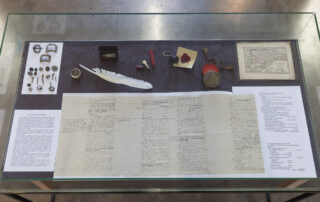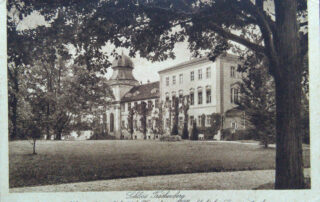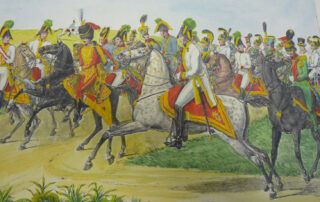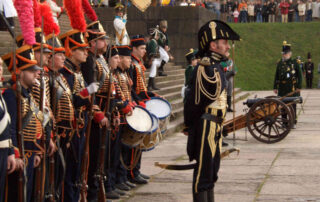Radetzky and the Trachenberg War Plan
by Kurt Anton Mitterer
Friedrich J. Heller von Hellwald published shortly after the 1858 death of Field Marshall Radetzky, a copy of his operative concept for the 1813 campaign against the French emperor Napoleon I and the Rhein coalition. The document went into military history as the “Trachenberg War Plan.”
A hand written draft, a working example, of this unique historical planning document exists in Salzburg’s Military History Museum (Salzburger Wehrgeschichtliches Museum, SWGM). The basic ideas for operational procedures of the allied armies were developed three months before Austria entered the war by Field Marshall Lieutenant Josef W. Radetzky Earl of Radetz (1766-1858) who was the Chief-of-staff for the Commander-in-chief of all of the allied armies, Field Marshall Karl Fürst Schwarzenberg. These documents were drafted two months before the final commitment to the united campaign in the conference in Trachenberg/Zmigròd (POL), and resulted in the name “Trachenberg War Plan.”
Despite original considerations, all of the Allies agreed with the Austrian operations plan to be sure that Austria could not leave the alliance against Napoleon at the last minute. The main consideration was a separated allied offensive linked with a destruction tactic. In order to ensure success in the decisive battle the “maximum of power and measurable superiority” had to be secured. The operation from the outer lines was accepted as advantageous for a destructive “cat and mouse game” until, after a battue, a deciding battle with concentric marching, member superior armies could successfully take over their opponents.
This operation plan stumbled again and again upon critic from the majority of the allied generals and from Tsar Alexander I. In the areas where the plan could not be followed, the Allies would have to accept setbacks. Where, in contrast, the plan found a more consequent application, the French would experience heavy losses.
Radetzky’s military strategy views were in effect set-through during the war. They peaked in the Allied win in the Völkerschlacht near Leipzig and lasted until the conquest of Paris in 1814.
An ongoing examination of the particularly difficult work run-down in the Allied headquarters is being done for the first time. The application of Radetzky‘s operative ideas written in the Trachenberg War plan were considered extremely difficult until now because the wishes and needs of the emperors and the new suggestions of their advisors had to be taken into consideration. In the end the Foreign Minister Metternich succeeded again and again in a diplomatic manner to hold the allies on Schwarzenberg’s and Radetzky’s course of success.
Many statesmen and commander-in-chiefs participated as always after a win. Their names fill the face books and innumerable documents in all lands. Today the participation and the roll of Austria is being discussed again on the level of objects. The military leadership duo Schwarzenberg-Radetzky enters with respect into the current research as well as their testimonial resources.
Translation: Margaret Teichmann, MSc
An original working copy of the Trachenberg War Plan of 1813 from the planning staff under the direction of Field Marshal Lieutenant Josef Graf Radetzky. Salzburger Wehrgeschichtliches Museum (SWGM).
Postcard of Trachenberg Castle around 1927. Franz Ludwig Fürst von Hatzfeldt zu Trachenberg (1756-1827) made the castle available for the negotiations of the Allies. Note the picture explanation at the bottom of the postcard: „Trachenberg Castle. On 12 July 1813, the war plan for the Battle of Leipzig was drawn up in this„ SWGM.
Colored copper engraving K.K. Oesterr. Generality; Artaria Vienna.
Every year, commemorations take place at the Monument to the Battle of the Nations. Photo SWGM.
Source References:
Friedrich Jakob Heller von Hellwald: Der k.k. österreichische Feldmarschall Graf Radetzky. Eine biographische Skizze nach den eigenen Dictaten und der Correspondenz des Feldmarschalls von einem österreichischen Veteranen, Stuttgart, Augsburg 1858.
Friedrich Jakob Heller von Hellwald: Denkschriften militärisch-politischen Inhalts aus dem handschriftlichen Nachlaß des k.k. österreichischen Feldmarschalls Grafen Radetzky, Stuttgart, Augsburg 1858.
Kriegsarchiv Wien (KA), Alte Feldakten (AFA) 1813/Deutschland-Hauptarmee (Dtld-HA)/VII/38, 80;
Salzburger Wehrgeschichtliches Museum (SWGM)/Archiv für Nachlässe von Militärpersonen (ANM)1813, S. 1 – 8.
Bibliography:
Oskar Regele: Feldmarschall Radetzky. Leben – Leistung – Erbe, Wien, München 1957.
Kurt Peball: Zum Kriegsbild der österreichischen Armee und seiner geschichtlichen Bedeutung in den Kriegen gegen die Französische Revolution und Napoleon I. in den Jahren von 1792 bis 1815, in: Napoleon I. und das Militärwesen seiner Zeit, hrsg. von Wolfgang von Groote und Klaus-Jürgen Müller, Freiburg i. B. 1968.
Kurt Anton Mitterer: 1813 – Kampf um Europa, in: Forum Salzburger Volkskultur, Salzburg 2013. ISSN 1563-2881.
Kurt Anton Mitterer: Die Rolle Österreichs im Feldzug 1813 – „Die für Europas Freiheit kämpfenden Scharen …“, in: 1813 – Kampf für Europa. Die Österreicher in der Völkerschlacht bei Leipzig, Festschrift anlässlich der Ausstellung des Salzburger Wehrgeschichtlichen Museums zum 200. Jahrestag zur Völkerschlacht bei Leipzig im Schloss Markkleeberg bei Leipzig; Dresden, Markkleeberg 2013. ISBN 978-3-00-041818-1.
Kurt Anton Mitterer: Der Trachenberger Kriegsplan, in: Zeitschrift Truppendienst. Zeitschrift für Ausbildung, Führung und Einsatz im Österreichischen Bundesheer – Folge 335, Ausgabe 5/2013, Wien 2013.
Kurt Anton Mitterer: Radetzky und der Trachenberger Kriegsplan von 1813, in: Pallasch, Zeitschrift für Militärgeschichte – Organ der Österreichischen Gesellschaft für Heereskunde, Bd. 70, Salzburg 2019. ISBN 978-3-902721-70-9.




